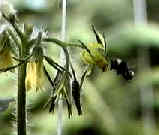

 Tomato
flowers are normally wind pollinated, however there is not enough
air movement in a crowded greenhouse to ensure good pollination.
Therefore, growers have two options for pollinating their crop:
mechanically pollinate or maintain hives of bumblebees in the
greenhouse.
Tomato
flowers are normally wind pollinated, however there is not enough
air movement in a crowded greenhouse to ensure good pollination.
Therefore, growers have two options for pollinating their crop:
mechanically pollinate or maintain hives of bumblebees in the
greenhouse.
Mechanical pollination entails shaking or vibrating each flower cluster at least every two days when humidity and temperature conditions are best. Generally, midday and early afternoon during sunny conditions when humidity is about 70% is best. Greenhouse temperatures should be kept above 65° F (15° C) at night and below 85° F (29° C) during the day. Even if conditions are not ideal, pollination should be attempted. Although tapping or shaking the entire vine will move some pollen, the best approach is to use an electric vibrator on each truss. Commercially available pollinators have a very forceful action, battery operated toothbrushes also work well.
 The
more efficient method of pollinating large greenhouses of
tomatoes is through the use of bumblebees. However, maintaining a
healthy hive requires an integrated management approach. It is
imperative that there is a proper balance of tomato flowers and
bees. One hive will work approximately one half acre (0.2
hectare) of tomatoes. Bumblebee hives cost several hundred
dollars each, and may only last a few months. The hives are
housed in cardboard boxes with a sugar water solution to supply a
balanced diet for the bees. The bees pose no threat to people
working in the greenhouse, but will be devastated by any
insecticides used on the crop. Therefore, bumblebee pollination
works well in pesticide-free greenhouses, assuring efficient,
complete pollination.
The
more efficient method of pollinating large greenhouses of
tomatoes is through the use of bumblebees. However, maintaining a
healthy hive requires an integrated management approach. It is
imperative that there is a proper balance of tomato flowers and
bees. One hive will work approximately one half acre (0.2
hectare) of tomatoes. Bumblebee hives cost several hundred
dollars each, and may only last a few months. The hives are
housed in cardboard boxes with a sugar water solution to supply a
balanced diet for the bees. The bees pose no threat to people
working in the greenhouse, but will be devastated by any
insecticides used on the crop. Therefore, bumblebee pollination
works well in pesticide-free greenhouses, assuring efficient,
complete pollination.
 A quote from
the Penn State University program perspectives sums up the use of
bumblebees well:
A quote from
the Penn State University program perspectives sums up the use of
bumblebees well:
"Tomato growers who eliminate pesticides in the greenhouse can use bumblebee hives to pollinate their crops, saving 15 hours of labor per acre [per day] required for manual pollination. Research indicated that bumblebees pollinate more efficiently, leading to yield increases of as much as 25 percent."